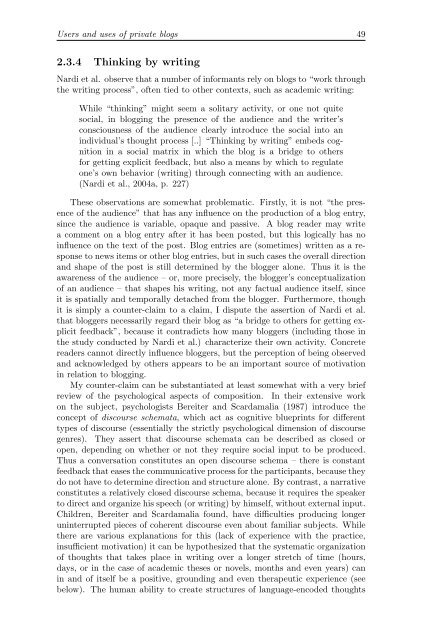The corporate blog as an emerging genre of computer ... - Oapen
The corporate blog as an emerging genre of computer ... - Oapen
The corporate blog as an emerging genre of computer ... - Oapen
You also want an ePaper? Increase the reach of your titles
YUMPU automatically turns print PDFs into web optimized ePapers that Google loves.
Users <strong>an</strong>d uses <strong>of</strong> private <strong>blog</strong>s 49<br />
2.3.4 Thinking by writing<br />
Nardi et al. observe that a number <strong>of</strong> inform<strong>an</strong>ts rely on <strong>blog</strong>s to “work through<br />
the writing process”, <strong>of</strong>ten tied to other contexts, such <strong>as</strong> academic writing:<br />
While “thinking” might seem a solitary activity, or one not quite<br />
social, in <strong>blog</strong>ging the presence <strong>of</strong> the audience <strong>an</strong>d the writer’s<br />
consciousness <strong>of</strong> the audience clearly introduce the social into <strong>an</strong><br />
individual’s thought process [..] “Thinking by writing” embeds cognition<br />
in a social matrix in which the <strong>blog</strong> is a bridge to others<br />
for getting explicit feedback, but also a me<strong>an</strong>s by which to regulate<br />
one’s own behavior (writing) through connecting with <strong>an</strong> audience.<br />
(Nardi et al., 2004a, p. 227)<br />
<strong>The</strong>se observations are somewhat problematic. Firstly, it is not “the presence<br />
<strong>of</strong> the audience” that h<strong>as</strong> <strong>an</strong>y influence on the production <strong>of</strong> a <strong>blog</strong> entry,<br />
since the audience is variable, opaque <strong>an</strong>d p<strong>as</strong>sive. A <strong>blog</strong> reader may write<br />
a comment on a <strong>blog</strong> entry after it h<strong>as</strong> been posted, but this logically h<strong>as</strong> no<br />
influence on the text <strong>of</strong> the post. Blog entries are (sometimes) written <strong>as</strong> a response<br />
to news items or other <strong>blog</strong> entries, but in such c<strong>as</strong>es the overall direction<br />
<strong>an</strong>d shape <strong>of</strong> the post is still determined by the <strong>blog</strong>ger alone. Thus it is the<br />
awareness <strong>of</strong> the audience – or, more precisely, the <strong>blog</strong>ger’s conceptualization<br />
<strong>of</strong> <strong>an</strong> audience – that shapes his writing, not <strong>an</strong>y factual audience itself, since<br />
it is spatially <strong>an</strong>d temporally detached from the <strong>blog</strong>ger. Furthermore, though<br />
it is simply a counter-claim to a claim, I dispute the <strong>as</strong>sertion <strong>of</strong> Nardi et al.<br />
that <strong>blog</strong>gers necessarily regard their <strong>blog</strong> <strong>as</strong> “a bridge to others for getting explicit<br />
feedback”, because it contradicts how m<strong>an</strong>y <strong>blog</strong>gers (including those in<br />
the study conducted by Nardi et al.) characterize their own activity. Concrete<br />
readers c<strong>an</strong>not directly influence <strong>blog</strong>gers, but the perception <strong>of</strong> being observed<br />
<strong>an</strong>d acknowledged by others appears to be <strong>an</strong> import<strong>an</strong>t source <strong>of</strong> motivation<br />
in relation to <strong>blog</strong>ging.<br />
My counter-claim c<strong>an</strong> be subst<strong>an</strong>tiated at le<strong>as</strong>t somewhat with a very brief<br />
review <strong>of</strong> the psychological <strong>as</strong>pects <strong>of</strong> composition. In their extensive work<br />
on the subject, psychologists Bereiter <strong>an</strong>d Scardamalia (1987) introduce the<br />
concept <strong>of</strong> discourse schemata, which act <strong>as</strong> cognitive blueprints for different<br />
types <strong>of</strong> discourse (essentially the strictly psychological dimension <strong>of</strong> discourse<br />
<strong>genre</strong>s). <strong>The</strong>y <strong>as</strong>sert that discourse schemata c<strong>an</strong> be described <strong>as</strong> closed or<br />
open, depending on whether or not they require social input to be produced.<br />
Thus a conversation constitutes <strong>an</strong> open discourse schema – there is const<strong>an</strong>t<br />
feedback that e<strong>as</strong>es the communicative process for the particip<strong>an</strong>ts, because they<br />
do not have to determine direction <strong>an</strong>d structure alone. By contr<strong>as</strong>t, a narrative<br />
constitutes a relatively closed discourse schema, because it requires the speaker<br />
to direct <strong>an</strong>d org<strong>an</strong>ize his speech (or writing) by himself, without external input.<br />
Children, Bereiter <strong>an</strong>d Scardamalia found, have difficulties producing longer<br />
uninterrupted pieces <strong>of</strong> coherent discourse even about familiar subjects. While<br />
there are various expl<strong>an</strong>ations for this (lack <strong>of</strong> experience with the practice,<br />
insufficient motivation) it c<strong>an</strong> be hypothesized that the systematic org<strong>an</strong>ization<br />
<strong>of</strong> thoughts that takes place in writing over a longer stretch <strong>of</strong> time (hours,<br />
days, or in the c<strong>as</strong>e <strong>of</strong> academic theses or novels, months <strong>an</strong>d even years) c<strong>an</strong><br />
in <strong>an</strong>d <strong>of</strong> itself be a positive, grounding <strong>an</strong>d even therapeutic experience (see<br />
below). <strong>The</strong> hum<strong>an</strong> ability to create structures <strong>of</strong> l<strong>an</strong>guage-encoded thoughts


